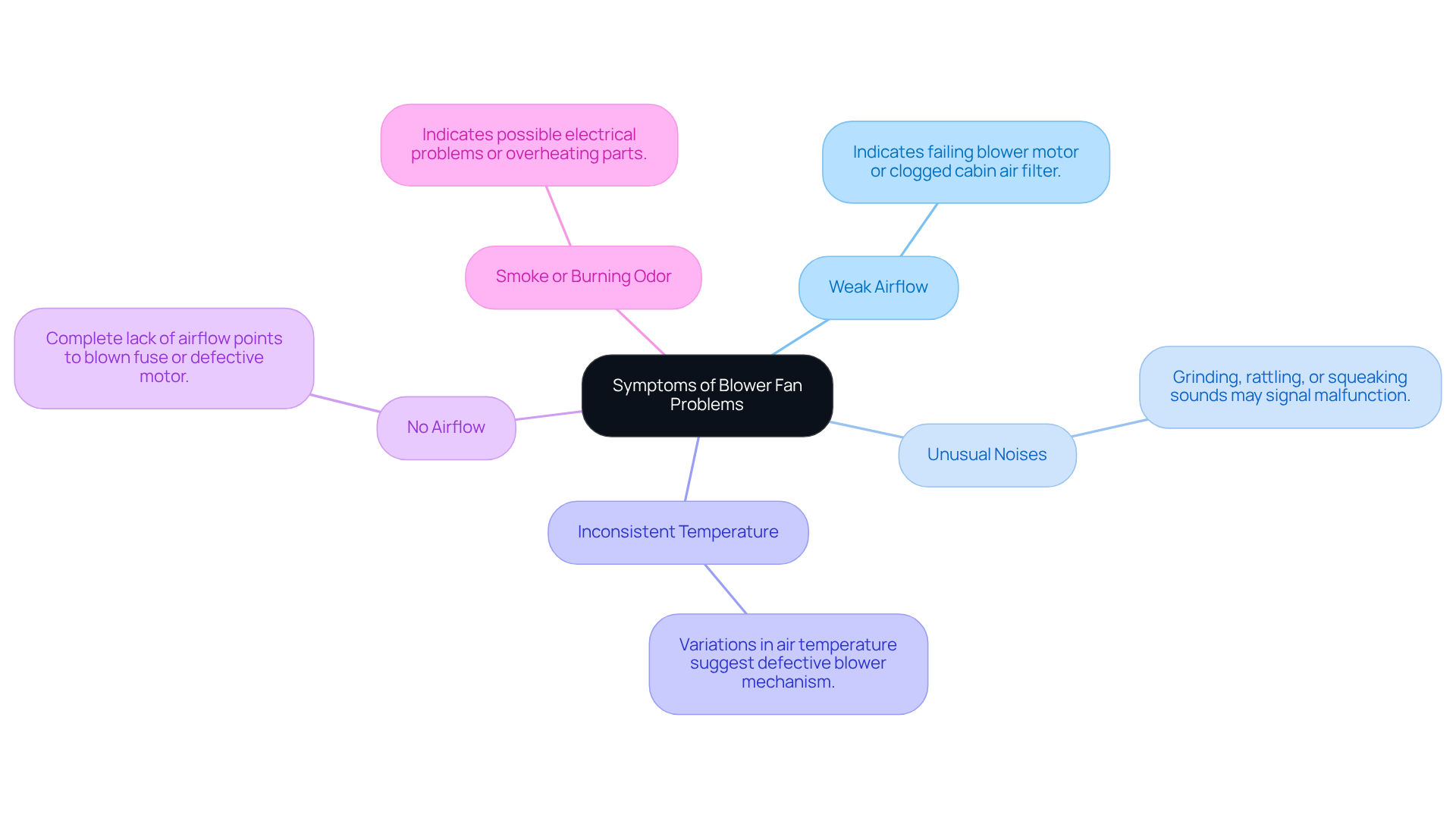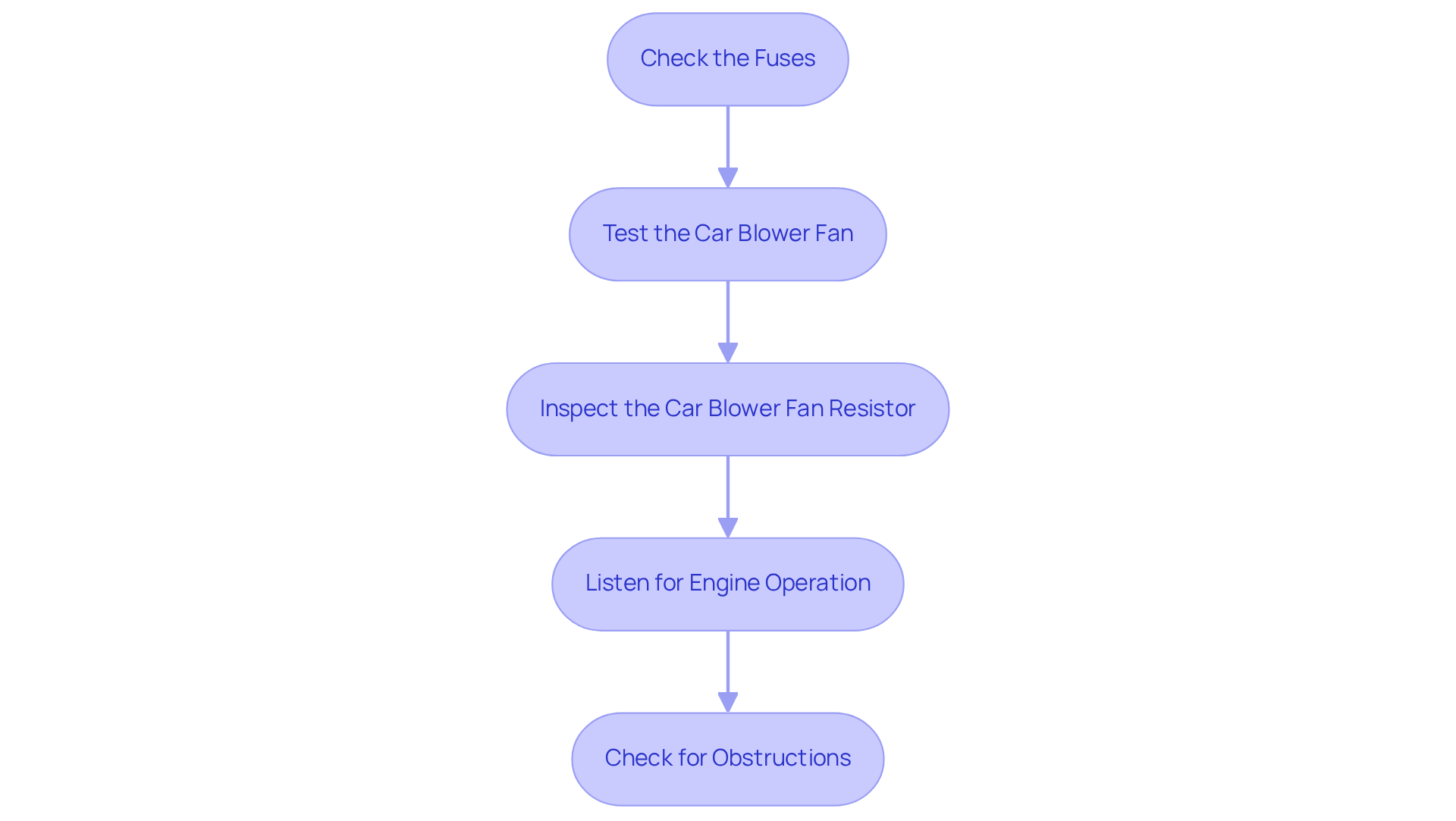Overview
This article serves as a comprehensive guide for diagnosing and repairing issues with a car blower fan. Understanding the system’s components and recognizing the symptoms of failure are crucial for effective troubleshooting. By following a step-by-step approach, readers can confidently diagnose and repair their blower fan issues.
DIY repairs not only save significant costs but also ensure optimal HVAC performance in vehicles. This guide emphasizes the importance of taking action, as addressing blower fan problems promptly can prevent further complications and enhance overall vehicle comfort.
In summary, this article equips readers with the knowledge and tools necessary to tackle blower fan issues effectively, reinforcing the value of self-repair in maintaining vehicle performance.
Introduction
Understanding the complexities of a car’s blower fan system is crucial for ensuring comfort and air quality within your vehicle. With around 70% of new cars now featuring electric fan motors, the significance of this component is more pronounced than ever. This guide delves into diagnosing and repairing common blower fan issues, equipping vehicle owners with the knowledge to address problems such as weak airflow and unusual noises.
However, what do you do when a simple fix uncovers deeper mechanical challenges? How can you navigate the intricacies of automotive repairs without racking up significant costs?
Let’s explore these questions together.
Understand the Car Blower Fan System
The car blower fan system is crucial for a vehicle’s heating, ventilation, and air conditioning (HVAC) system. It comprises a fan unit that circulates air throughout the system and a fan that distributes this air into the cabin. Typically, the car blower fan operates as an electric device with multiple speeds, allowing for tailored climate control based on user preferences. Notably, recent developments show that around 70% of new vehicles now feature electric fan motors, marking a significant shift towards more efficient and responsive HVAC systems.
Gagner-Toomey Associates stands as the world’s largest producer of standard and custom air-movers, offering a comprehensive range of DC input tube axial devices and centrifugal air movers. These products are optimized for performance, efficiency, and low noise, making them essential for automotive applications. Their innovative cooling solutions come in sizes ranging from 15 to 280mm for tube axial fans and 15 to 225mm for centrifugal devices, ensuring effective thermal management in vehicles. Furthermore, Gagner-Toomey provides thermal management solutions, including extruded aluminum heatsinks, copper-based heat sinks, and liquid cooling options.
Understanding the various components involved—such as the air mover, fan, resistors, and control switches—is crucial for effective troubleshooting. The fan unit draws energy from the vehicle’s battery and is regulated by a series of relays and switches that adjust the fan speed according to user input. Automotive engineers emphasize that a well-functioning ventilation unit is critical for maintaining optimal cabin comfort and air quality. Symptoms of car blower fan failure may include weak airflow, operation at limited speeds, or inconsistent temperature regulation. Identifying issues with the fan unit often requires expert examination due to the challenges in accessing the unit. Familiarizing yourself with these components will enable you to recognize potential problems more readily, underscoring the importance of regular maintenance and timely diagnosis.

Identify Symptoms of Blower Fan Problems
Common symptoms of blower fan problems include:
- Weak Airflow: A noticeable reduction in airflow from the vents often indicates a failing blower motor or a clogged cabin air filter. Studies show that a significant percentage of drivers experience weak airflow in their vehicles, underscoring the prevalence of this issue.
- Unusual Noises: Sounds such as grinding, rattling, or squeaking may signal that the fan unit is malfunctioning or that debris is obstructing the fan. Technicians frequently encounter these noises during diagnostics, which can lead to timely repairs.
- Inconsistent Temperature: Variations in air temperature may suggest a defective blower mechanism or issues with the HVAC controls. This symptom can lead to discomfort and should be addressed promptly.
- No Airflow: A complete lack of airflow from the vents typically points to a blown fuse, a defective motor, or a failed resistor. This problem can severely impact the vehicle’s climate control capabilities.
- Smoke or Burning Odor: This concerning sign indicates possible electrical problems or overheating parts, requiring immediate attention to prevent further damage.
Identifying these symptoms promptly is crucial for diagnosing and resolving fan problems efficiently, ensuring optimal performance of your vehicle’s HVAC system.

Diagnose the Blower Fan Issue
To diagnose the blower fan issue, follow these essential steps:
-
Check the Fuses: Begin by inspecting the fuses associated with the ventilation system. A blown fuse can prevent the engine from receiving power. Consult your vehicle’s manual for the fuse box location and specifications.
-
Test the car blower fan: Utilize a multimeter to check for voltage at the car blower fan connector. If there is no voltage, the problem may stem from the wiring or the control switch.
-
Inspect the car blower fan resistor: The fan speed resistor regulates airflow. If the engine operates only at specific speeds, the resistor could be defective. Test it for continuity using a multimeter.
-
Listen for Engine Operation: Activate the car blower fan and listen for any noises coming from the engine. If you hear a humming noise but no airflow, the motor may be jammed or defective.
-
Check for obstructions: Examine the car blower fan for any debris or blockages that could impede airflow. Carefully remove any obstructions.
By following these diagnostic steps, you can effectively identify the issue affecting your fan and prepare for the necessary repairs.

Repair the Blower Fan
To effectively repair the blower fan, follow these essential steps:
- Disconnect the Battery: For safety, always disconnect the negative terminal of the battery before starting any repairs. This action prevents accidental electrical shorts and ensures a safe working environment.
- Check for Blown Fuses: Before proceeding, inspect for any blown fuses, as this could be a preliminary issue affecting the fan’s operation.
- Remove the Air Circulation Unit: Locate the air circulation unit, typically found beneath the dashboard on the passenger side. Carefully remove any screws or clips holding it in place, and detach the electrical connector to release the device.
- Inspect and Replace Components: Examine the fan mechanism for signs of wear or damage. If it appears faulty, replace it with a new unit. Additionally, if the fan resistor was identified as faulty during your assessment, consider substituting it to ensure optimal performance.
- Reassemble the System: After completing the necessary repairs, reattach the fan motor, securing it with screws or clips. Reconnect the electrical connector to restore power.
- Reconnect the Battery: Reconnect the negative terminal of the battery and test the fan to confirm it operates correctly.
- Final Check: Start the vehicle and test the HVAC system at different speeds to ensure the fan is functioning properly.
By following these detailed repair steps, you can effectively restore the functionality of your car blower fan, enhancing your driving comfort. Statistics indicate that DIY repairs can save approximately $800 in labor costs, making this a cost-effective solution for many car owners. Furthermore, the average cost of blower motor replacement ranges from $550 to $650, underscoring the financial benefits of undertaking this repair yourself. While DIY repairs can be rewarding, it’s crucial to recognize when professional help is necessary to avoid potential high repair bills.

Conclusion
Mastering the complexities of the car blower fan system is crucial for any vehicle owner aiming to maintain optimal comfort and functionality. This guide offers a thorough overview of the blower fan system, underscoring its vital role in the HVAC setup, identifying symptoms of potential malfunctions, and providing a step-by-step approach to diagnosing and repairing common issues.
Key points include recognizing various symptoms such as:
- Weak airflow
- Unusual noises
- Inconsistent temperature regulation
These may signal underlying problems. The diagnostic steps outlined—ranging from checking fuses to inspecting the blower fan motor—equip readers with the essential tools for effective troubleshooting. Additionally, the repair process highlights the importance of safety and thoroughness, ensuring that each step is executed carefully to restore the system’s performance.
Understanding and addressing car blower fan issues not only enhances driving comfort but also promotes the longevity of the vehicle’s HVAC system. By taking proactive measures in diagnosing and repairing blower fan problems, vehicle owners can save on costly repairs and ensure a pleasant driving experience. Regular maintenance and awareness of malfunction signs empower individuals to take control of their vehicle’s comfort, leading to informed decisions that ultimately enhance their ride.
Frequently Asked Questions
What is the function of the car blower fan system?
The car blower fan system is essential for a vehicle’s heating, ventilation, and air conditioning (HVAC) system, as it circulates air throughout the system and distributes it into the cabin.
How does the car blower fan operate?
The car blower fan typically operates as an electric device with multiple speeds, allowing for tailored climate control based on user preferences.
What percentage of new vehicles feature electric fan motors?
Around 70% of new vehicles now feature electric fan motors, indicating a shift towards more efficient and responsive HVAC systems.
Who is Gagner-Toomey Associates and what do they offer?
Gagner-Toomey Associates is the world’s largest producer of standard and custom air-movers, providing a range of DC input tube axial devices and centrifugal air movers optimized for performance, efficiency, and low noise for automotive applications.
What sizes do Gagner-Toomey’s fans come in?
Gagner-Toomey’s tube axial fans come in sizes ranging from 15 to 280mm, while centrifugal devices range from 15 to 225mm.
What are the key components of the car blower fan system?
Key components include the air mover, fan, resistors, and control switches, which are crucial for effective troubleshooting.
How does the fan unit receive power and adjust speed?
The fan unit draws energy from the vehicle’s battery and is regulated by a series of relays and switches that adjust the fan speed according to user input.
What are the symptoms of car blower fan failure?
Symptoms of car blower fan failure may include weak airflow, operation at limited speeds, or inconsistent temperature regulation.
Why is it important to understand the components of the car blower fan system?
Familiarizing yourself with the components of the car blower fan system helps in recognizing potential problems and underscores the importance of regular maintenance and timely diagnosis.

